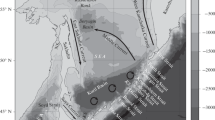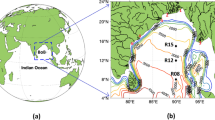Abstract
This work concerns an analysis of inter-basin and inter-layer exchanges in the component ocean part of the coupled ECHAM4/OPYC3 general circulation model, aimed at documenting the simulation of North Atlantic Deep Water (NADW) and related thermohaline circulations in the Indian and Pacific Oceans. The modeled NADW is formed mainly in the Greenland– Iceland–Norwegian Seas through a composite effect of deep convection and downward cross-isopycnal transport. The modeled deep-layer outflow of NADW can reach 16 Sv near 30 °S in the South Atlantic, with the corresponding upper-layer return flow mainly coming from the “cold water path” through Drake Passage. Less than 4 Sv of the Agulhas “leakage” water contributes to the replacement of NADW along the “warm water path”. In the South Atlantic Ocean, the model shows that some intermediate isopycnal layers with potential densities ranging between 27.0 and 27.5 are the major water source that compensate the NADW return flow and enhance the Circumpolar Deep Water (CDW) flowing from the Atlantic into Indian Ocean. The modeled thermohaline circulations in the Indian and Pacific Oceans indicate that the Indian Ocean may play the major role in converting deep water into intermediate water. About 16 Sv of the CDW-originating deep water enters the Indian Ocean northward of 31 °S, of which more than 13 Sv “upwell” mainly near the continental boundaries of Africa, South Asia and Australia through inter-layer exchanges and return to the Antarctic Circumpolar Current (ACC) as intermediate-layer water. As a contrast, only 4 Sv of Pacific intermediate water is connected to “upwelling” flow southward across 31 °S while the magnitude of northward deep flow across 31 °S in the Pacific Ocean is significantly greater than that in the Indian Ocean. The model suggests that a large portion of the deep waters entering the Pacific Ocean (about 14 Sv) “upwells” continually into some upper layers through the thermocline, and becomes the source of the Indonesian throughflow. Uncertainties in these results may be related to the incomplete adjustment of the model’s isopycnal layers and the sensitivity of the Indonesian throughflow to the model’s geography and topography.
Similar content being viewed by others
Author information
Authors and Affiliations
Additional information
Received: 12 August 1997/Accepted: 12 March 1998
Rights and permissions
About this article
Cite this article
Zhang, XH., Oberhuber, J., Bacher, A. et al. Interpretation of interbasin exchange in an isopycnal ocean model. Climate Dynamics 14, 725–740 (1998). https://doi.org/10.1007/s003820050251
Issue Date:
DOI: https://doi.org/10.1007/s003820050251




